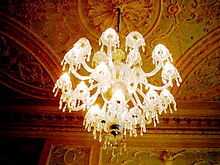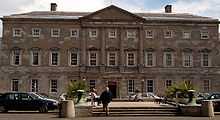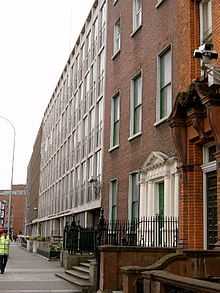Georgian Dublin

Georgian Dublin is a phrase used in the History of Dublin that has two interwoven meanings,
- to describe a historic period in the development of the city of Dublin, Ireland, from 1714 (the beginning of the reign of King George I of Great Britain and of Ireland) to the death in 1830 of King George IV. During this period, the reign of the four Georges, hence the word Georgian, covers a particular and unified style, derived from Palladian Architecture, which was used in erecting public and private buildings;
- to describe the modern day surviving buildings in Dublin erected in that period and which share that architectural style.
Though strictly speaking, Georgian architecture could only exist during the reigns of the four Georges, it had its antecedents prior to 1714 and its style of building continued to be erected after 1830, until replaced by later styles named after the then monarch, Queen Victoria, i.e. Victorian.
Dublin's development
Dublin was for much of its existence a medieval city, marked by the existence of a particular style of buildings, built on narrow winding medieval streets. The first major changes to this pattern occurred during the reign of King Charles II when the then Lord Lieutenant of Ireland, the Earl of Ormonde (later made Duke of Ormonde) issued an instruction which was to have dramatic repercussions for the city as it exists today. Though the city over the century had grown around the River Liffey, its buildings as in many other medieval centres backed onto the river, often allowing for the dumping of household waste directly into the river, it being a form of collective sewer. As Dublin's quays underwent development, Ormonde insisted that the frontages of the houses, not their rears, should face the quay sides, with a street to run along each quay. By this one development, Ormond changed the face of the city. No longer would the river be a sewer hidden between buildings. Instead it became a central feature of the city, with its quays lined by large three and four storey houses and public buildings, such as the Four Courts, the old Custom House and, later and grander, The Custom House designed, as was the Four Courts, by master architect James Gandon. For his initiative, Ormonde's name is now given to one of the city quays.
It was however only one of a number of crucial developments. As the city grew in size, stature, population and wealth, two changes were needed. (1) The existing narrow-streeted medieval city required major redevelopment, and (2) major new development of residential areas was required.
Rebuilding Dublin's Core

A ceiling from the Dublin townhouse of Viscount Powerscourt, showing the splendour of Georgian decoration. His former townhouse was sensitively turned into a shopping centre in the 1980s.
18th Century Property Developers
.jpg)
While the rebuilding by the Wide Streets Commission fundamentally changed the streetscape in Dublin, a property boom led to additional building outside the central core. Unlike twentieth century building booms in Dublin the eighteenth century developments were carefully controlled. The developing areas were divided into precincts, each of which was given to a different developer. The scope of their developments were restricted, however, with strict controls imposed on style of residential building, design of buildings and location, so producing a cohesive unity that came to be called Georgian Dublin.
.jpg)
Initially developments were focused on the city's northside. Among the earliest developments was Henrietta Street, a wide street lined on both sides by massive Georgian houses built on a palatial scale. At the top end of the street, a new James Gandon building, the King's Inns, was erected between 1795 and 1816. In this building, barristers were trained and earned their academic qualifications. Such was the prestige of the street that many of the most senior figures in Irish 'establishment' society, peers of the realm, judges, barristers, bishops bought houses here. Under the anti-Catholic Penal Laws, Roman Catholics, though the overwhelming majority in Ireland, were harshly discriminated against, barred from holding property rights or from voting in parliamentary elections until 1793. Thus the houses of Georgian Dublin, particularly in the early phase before Catholic Emancipation was granted in 1829, were almost invariably owned by a small Church of Ireland Anglican elite, with Catholics only gaining admittance to the houses as skivvies and servants. Ultimately the northside was laid out centred on two major squares, Rutland Square (now called Parnell Square for Charles Stewart Parnell), at the top end of Sackville Street, and Mountjoy Square. Such was the prestige of the latter square that among its many prominent residents was the Church of Ireland Archbishop of Dublin. Many of the streets in the new areas were named after the property developers, often with developers commemorated both in their name and by their peerage when the received one. Among the streets named after developers are Capel Street, Mountjoy Square and Aungier Street.

The main body of the Castle was rebuilt along Georgian lines following a disastrous fire in the late seventeenth century
For the initial years of the Georgian era, the northside was the place to live. However, when the Earl of Kildare chose to move to a new large ducal palace built for him on what up to that point was seen as the inferior southside, he caused shock. When his Dublin townhouse, Kildare House (renamed Leinster House when he was made Duke of Leinster) was finished, it was by far the biggest aristocratic residence other than Dublin Castle, and it was greeted with envy.
The Earl had predicted that his move would be followed, and it was. Three new residential squares appeared on the southside, Merrion Square (facing his residence's garden front), St Stephen's Green and the smallest and last of Dublin's five Georgian squares to be built, Fitzwilliam Square. Aristocrats, bishops and the wealthy sold their northside townhouses and migrated to the new southside developments, even though many of the developments, particularly in Fitzwilliam Square, were smaller and less impressive than the buildings in Henrietta Street. While the wealthier people lived in houses on the squares, those with lesser means and lesser titles lived in smaller, less grand but still impressive developments off the main squares, such as Upper and Lower Mount Street and Leeson Street.
The Act of Union and Georgian Dublin

18th century ducal palace built by the Duke of Leinster. Since 1922 it has served as the seat of the modern Irish parliament, Oireachtas Éireann.

A surviving Georgian house on St. Stephen's Green, stuck between a Victorian building (picture right) and a 1960s office block (left). Over half the Georgian buildings on St. Stephen's Green having been lost since the Georgian era, with many demolished in the 1950s and 1960s .
Although the Irish Parliament was composed exclusively of representatives of the minority Protestant community in Ireland, it did show sparks of independence, most notably the achievement of full legislative independence in 1782, where all the restrictions previously surrounding the parliament in College Green, notably Poynings' Law were repealed. This period of legislative freedom however was short-lived. In 1800, under pressure from the Dublin Castle administration of the Lord Lieutenant of Ireland and amid mass bribery, both the House of Commons and the House of Lords passed the Irish Act of Union, uniting both the Kingdom of Ireland and its parliament with the Kingdom of Great Britain and its parliament in London. As a result, from 1 January 1801 Dublin found itself without a parliament with which to draw hundreds of peers and bishops, along with their thousands of servants. While many did come to Dublin still for the Social Season, where the Lord Lieutenant hosted debutantes balls, state balls and drawing rooms in a period from January until St. Patrick's Day (17 March) every year, many found them less appealing than in the days when they could sit in parliament for a session in College Green. Many of the leading peers, including the Duke of Leinster and Viscount Powerscourt, almost immediately sold their palatial Dublin townhouses, Powerscourt House and Leinster House. Though many still flocked to Dublin every social season, many didn't or went to London. The loss of their revenue and that of their extensive staff hurt the Dublin economy severely. While the 'new' Georgian centres southside continued to flourish, the northside Georgian squares soon fell into squalor, as new owners of the buildings crammed in massive numbers of poor into the former residences of earls and bishops, in some cases cramming an entire family into one old drawing room. Mountjoy Square in particular became run-down, until such was its state and degree of dereliction in the 1980s that it was used as a film set for stories set in post-blitz London and post-war Berlin. The empty shells of the graceful houses, reduced to unsanitary tenements before being demolished in the 1980s, were used as a backdrop for a U2 rock video.
Georgian Dublin today

In the years after independence in 1922, independent Ireland had little sympathy for Georgian Dublin, seeing it as a symbol of British rule and of the unionist identity that was alien to Irish identity. By that stage, many of the gentry who had lived in them had moved elsewhere; some to the wealthy Victorian suburbs of Rathmines and Rathgar, Killiney and Ballsbridge, where Victorian residences were built on larger plots of land, allowing for gardens, rather that the lack of space of the Georgian eras. Those that had not moved in many cases had by the early twentieth century sold their mansions in Dublin. The abolition of the Dublin Castle administration and the Lord Lieutenant in 1922 saw an end to Dublin's traditional "Social Season" or masked balls, drawing rooms and court functions in the Castle. Many of the aristocratic families lost their heirs in the First World War, their homes in the country to IRA burnings (during the Irish War of Independence) and their townhouses to the Stock Market Crash of 1929. Daisy, the Countess of Fingall, in her regularly republished memoirs Seventy Years Young, wrote in the 1920s of the disappearance of that world and of her change from a big townhouse in Dublin, full of servants to a small flat with one maid. By the 1920s and certainly by the 1930s, many of the previous homes in Merrion Square had become business addresses of companies, with only Fitzwilliam Square of all the five squares having any residents at all. (Curiously, in the 1990s, new wealthy businessmen such as Sir Tony O'Reilly and Dermot Desmond began returning to live in former offices they had bought and converted back into homes.) By the 1930s, plans were discussed in Éamon de Valera's government to demolish all of Merrion Square, perhaps the most intact of the five squares, on the basis that the houses were "old fashioned" and "un-national". They were only saved by Adolf Hitler's invasion of Poland in 1939 and a general lack of capital and investment; the plans were put on hold in 1939 and forgotten about by 1945.

Though that did not stop the destruction of some of Georgian Dublin. Dublin's most perfectly planned square, Mountjoy Square, was under serious threat with almost all of the south side demolished by property speculators during the 1960s and 70s; even so, buildings with facsimile facades were subsequently built in place, re-completing the square's uniform external appearance as it stands today. The world's longest row of Georgian houses, running from the corner of Merrion Square down to Leeson Street Bridge, was sliced in two by the decision of the Irish government in the early 1960s to demolish part of the row and replace them by a modern office block.

By the 1990s, attitudes had changed dramatically. Strict new planning guidelines sought to protect the remaining Georgian buildings, though some property owners still found their way around the restrictions. A surprising number of old houses in poor repair, if an owner wished to demolish them but had been refused planning permission, just happened mysteriously to go on fire and be burnt to the ground, facilitating 'development'.[citation needed] However, in contrast with the lax development controls applied in Ireland for many decades, by the 1990s a whole new mindset among politicians, planners and the leaders of Dublin City Council (formerly Dublin Corporation) produced a determination to preserve as much as possible of the remaining Georgian buildings, with prosecutions for unauthorised developments becoming more regular (see An Bord Pleanála and An Taisce). However there are once again renewed fears for areas such as Parnell Street, James' Street andThomas Street. The war to preserve Georgian Dublin has not yet been won.
Perhaps the biggest irony for some is that residence that marked the move of the aristocrats from the northside to the southside (where the wealthier Dubliners have remained to this day), and that in some ways embodied Georgian Dublin, Leinster House, home of the Duke of Leinster, ended up as the parliament of independent republican Ireland; but his family also produced the republican leader Lord Edward Fitzgerald. The decision in the late 1950s to demolish a row of Georgian houses in Kildare Place and replace them with a brick wall was greeted with jubilation by a republican minister at the time, Kevin Boland, who said they stood for everything he opposed. He described members of the fledgling Irish Georgian Society, newly formed to seek to protect Georgian buildings, of being "belted earls".
See also
- Newtown Pery, Georgian Limerick